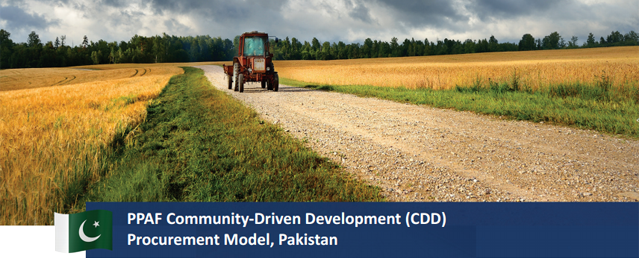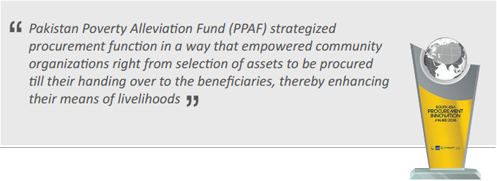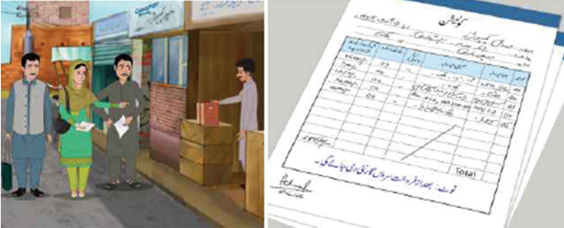Feature Stories
- How Bangladesh bridged the gap between amateur and professional in government procurement
- Rated Criteria: Promoting Value in World Bank Procurement
- Public Procurement Transformation in Bangladesh
- Achievement of Value for Money and Enhancement of Efficiency, Economy and Transparency in Procurement - Document Archive System
Archives
- End-to-End Procurement Planning and Maintenance System Integrated with Project MIS
- Application of Construction Milestones in Rural Road Contracts of Nepal
- Gross National Happiness Model for Pursuing Sustainable Public Procurement
- Government procurement is the basis of wide opportunities for enterprise development
- The Challenges of Procurement Training in a Fragile Country: the Afghanistan Experience
- When and How to Open Contracts: Transparency and Engagement through World Bank Projects
- Innovations and Best Practices in Procurement Processes of Disaster Recovery Projects
- World Bank Experts Discuss Global Procurement Trends and Armenia's e-GP system with the National Assembly
- Technology driving transparent and accountable public procurement reform in Bangladesh
- Prototype for Implementation of Framework Agreement via Blockchain
- Construction Project Planning and Management Capacity Building in India: A Wholistic Approach to Boost Infrastructure Development
- Zimbabwe: Public Procurement reform to catalyze greater transparency and development
- 15th Procurement, Integrity, Management and Openness (PRIMO) Forum
- e-Procurement World Map
- Preventing and controlling corruption: A modern approach to Procurement
- 6th South Asia Public Procurement Conference held in Thimphu, Bhutan
- South Asia Procurement Innovation Awards 2018 Announced
- Procurement iNET completes 5 years and new CPPP Fastest 100% Challenge Launched
- Risky Business: Does Debarring Poor Performers Mitigate Future Performance Risk?
- Global Procurement Summit 2019, New Delhi, India
- World Bank India launches Survey for International Civil Works Contractors
- World Bank launches new Complaints Module in Systematic Tracking of Exchanges in Procurement (STEP) System
- New Open Contracting Data Standard for e-Procurement Systems Launched
- Bangladesh's success in public procurement: Sustained reform really pays off
- The five drivers for improving public sector performance: Lessons from the new World Bank Global Report
- South Asia Public Procurement Innovation Awards 2018
- Conversation with Khaled Elarbi, President, High Authority for Public Procurement (HAICOP), Tunisia on the Digitalization of Public Procurement
- Breaking the glass ceiling in Africa: Rwanda E-Government Procurement System
- How government e-marketplace is revolutionizing procurement in India
- Ensuring Value for Money in Infrastructure Projects - The Botswana way
- Blockchain Lessons for Procurement
- Botswana’s Benevolent Move to Enhance its Procurement Profession
- Achieving Better Value for Money Using e-Auction for Procurement of Goods by Public Sector - A Success Case from DPDC
- Guide to Project Management and Contract Management (GPMCM) – New Approach to Improve Efficiency and Effectiveness of Procurement Outcomes
- Regional Winners of SAPIA 2017 participate in 8th International Public Procurement Conference (IPPC 8) Arusha, Tanzania
- The Future of Public Procurement in the Era of Digitalization
- World Bank Operations Procurement Helping Turkey to Procure a US$2 Billion Gas Storage Facility
- Unlocking Energy Efficiency Market in India - Through Innovative Procurement Business Model
- Getting value for money: Creating an automated market place for farmers in Pakistan
- Towards a Single Market for Public Procurement in Caribbean Small States
- Web-Based Online Evaluation Tool (e-Tool) for Procurement of Works by Royal Government of Bhutan
- Strengthening Health Sector Procurement System Offer Hopes for Universal Health Coverage in Nepal
- Morocco makes Strides in Modernizing its Public Procurement System— Operationalization of the Procurement Regulatory Body
- Innovations in Procurement Process and Selection that Lead to Improved Outcomes – Tenderers’ Database Management System
- Looking Back and Forward: The World Bank’s Procurement Framework
- Independent Monitoring and Evaluation of Contracted Health Services Leads to Improved Outcomes in Rural Areas of Afghanistan
- Fifth South Asia Region Public Procurement Conference brings focus on Procurement in Public Service Delivery
- 12 Procurement Innovations from South Asian Countries Celebrated
- Social Media is Improving Procurement in Lao PDR
- ASEAN meeting explores ways of professionalizing public procurement to meet development challenges
- Second International Training Program on the World Bank’s New Procurement Framework
- South Asia Procurement Innovations Award 2017 launched with Bigger and Better Prizes
- How to bid, finding opportunities, what makes a successful bid
- Pushing boundaries in procurement framework implementation
- Experience of Developing PPSD for the Assam Agribusiness and Rural Transformation Project (APART), India
- An Electronic Approach: Streamlining Georgia's Procurement
- South Asia Heads of Procurement Knowledge Exchange Program to U.S. Government Procurement Systems started
- 13th Procurement, Integrity, Management and Openness (PRIMO) Forum - a Documentary
- Bangladesh to strengthen public procurement with World Bank supported Project
- Establishment of Technology-Based Health Procurement and Supply Chain Management System, and Capacity Development in Tamil Nadu Medical Services Corporation
- Towards a Single Market for Public Procurement in Caribbean Small States
- Redefining Procurement as an Innovative and Collaborative Centre of Excellence for Best-in-Class Sourcing Solution
- India’s PowerGrid Endorsed for Alternative Procurement Arrangements by the World Bank
- Achieving Value for Money in Indonesia’s Geothermal Project
- Citizen Monitoring of Rural Roads Under Pradhan Mantri Gram Sadak Yojana (PMGSY), India
- Establishment of Grant and Service Contract Management Unit (GCMU) to Manage Contracting Out of Health Services in Afghanistan
- Procurement for Regional Development–Public Policy Initiative in Sri Lanka
- PPAF Community-Driven Development (CDD) Procurement Model, Pakistan
- Making Successful Procurement of IT Systems - An Experience from Vietnam
- Procurement Observatories continue to deliver in India
- Implementation of National e-GP System in Nepal
- Government e-Marketplace (GeM), India
- Africa High Level Public Procurement and Electronic Government Procurement Forums
- Development of Procurement Cadre as Part of Holistic Procurement Reforms in Bhutan
- Modernizing Public Procurement in Zimbabwe, one Step at a Time
- Citizen Engagement During Public Procurement Implementation in Bangladesh
- Winter 2017 Virtual Procurement, Integrity, Management, and Openness (PRIMO) Forum on Sanctions and Debarment Systems
- Close and Personalized Procurement Monitoring, Leading to Procurement Efficiency in Irrigation Sector in Fragile and Challenging Environments of Afghanistan
- Procurement Framework 2016 offers wider choices to ‘Go to Market’ based on PPSD
- Procurement Framework 2016 - Benefits, Status of Roll-out and M&E Arrangements
- PPSD offers Fit for Purpose Procurement Solutions
- Global Procurement Summit
- Fourth South Asia Region Public Procurement Conference
- The World Bank e-Procurement Tools
- South Asia Procurement Innovations Awards, 2016
- Learning Videos launched on STEP, online tracking tool on procurement for World Bank Projects
- Open e-Learning is Building a Cadre of Procurement Experts
- South Asia Region Public Procurement Conference, 2017
- Online Certificate Program in Public Procurement in Arabic Launched in Egypt
- First Procurement Knowledge Exchange Forum among ASEAN Countries
- Nobel Prize in Economics for contribution to Theory of Contract
- The Africa Region Harnesses Integrated e-Government Procurement (e-GP) Systems in Pursuit of Transparency and Integrity
- Procurement Reform for Humanitarian and Development Challenges in Kurdistan Region of Iraq (KRI)
- Successful Procurement is not just a set of Activities, it is a Strategy
- Afghanistan - Trends and Recent Developments in Governance
- PPSD is an Opportunity for clients and staff for Improved Procurement Management
- Procurement Reform Advances in the MENA Region
- Data Analysis and Collaborative Work in Action for Expedited Disbursements in Africa
- Ensuring Good Governance in Procurement in Sri Lanka
- New Procurement System to Improve Development Impact and Transparency in South Asia
- World Bank, USTDA Formalize Procurement Partnership
- How the New Procurement Framework Will Benefit 45.6 Million People in India
- Procuring the Future
- Reasons to Bid, Finding Business Opportunities
- New World Bank Procurement Framework Promotes Strengthened National Procurement Systems
- The readiness for Procurement Framework 2016
- 6 Things to know about New Procurement Framework
PPAF Community-Driven Development (CDD) Procurement Model, Pakistan


{This article is an abridged version of the submission on “PPAF CDD Procurement Model” made by Mr. Abdul Rehman, General Manager (Procurement), Pakistan Poverty Alleviation Fund (PPAF), for the South Asia Procurement Innovation Awards.}
Summary
In response to rising poverty, Government of Pakistan, with World Bank support, established an Apex institution, the Pakistan Poverty Alleviation Fund (PPAF), to serve as a specialized funding institution that guides poverty reduction through civil society organizations. It operates as an independent entity to identify and develop civil society organizations, and funds them for specific interventions, leading to socio-economic development.
At present, with 134 Partner Organizations, PPAF is working with Community Organizations present in 100,000 villages and 130 districts of Pakistan. With 70% of the funding spent on procurement, the engagement of Community Institutions (CIs) in procurement process has enhanced the livelihood of people.
Background
The interventions of PPAF are by and large in far-flung areas, where basic necessities of life are scarcely available. Initially, the Procurement Unit of PPAF did not have resources to design and deliver customized training programs on Financial Management, Record Keeping, and Community Procurement and Asset Management to over the then 1,200 Community Institutions (CIs). Responding to the situation, PPAF prepared “CDD Procurement Guidelines” in the local language Urdu, and presented all relevant procurement formats by way of animated films and pictorial booklets, so that they could be understood easily.
Around 70-80% of funding by PPAF is centered on procurement of assets to enhance livelihood options, schools and the community’s physical infrastructure schemes. Over time, there has emerged a shared understanding of accepting community-level procurement as a strategic underpinning to development.

The Community Institutions (CIs) that the PPAF involved initially lacked expertise of managing financial and procurement activities, and thus needed capacity building to make them self-sufficient. CIs were hence brought under the supervision of Partner Organizations (POs), with PPAF as the apex body. Together with the other relevant members from PPAF and Task teams, processes were developed that met the objectives of participation, efficiency and cost-effectiveness, quality of goods and services, and transparency. Such departure from a standoffish procurement support to a participative one at community level paid dividends. Help also came by way of Community Resource Persons (CRPs) to build local capacities. Over 4,000 CRPs (both male and female) were trained to further train members of Community Institutions.
In case of Community Procurement, goods are generally manufactured at local level. Resorting to competitive procurement methods proved counterproductive to principles of procurement. The PPAF thus developed a Community Procurement Manual in local language, with animated films and pictorial booklets for easy understanding of the CIs and local communities. The manual provides solutions to overcome difficulties while carrying out different types of local procurement. It also provides different formats pertaining to procurement and suggests how community can procure goods in case of non-availability of verifiable quotations, goods, and vendors.

Animated movies have been prepared on Community-Driven Development (CDD), covering the core concept of CDD, formation of CRPs, how to develop Union Council Development Program (UCDP), Financial management, Procurement process, Record keeping, and Capacity building. The animations pertain to the procurement process, informing how to initiate the procurement process; how to prepare the procurement plan, and why it is important to prepare the plan before initiation of any procurement process. It highlights how to establish procurement committees and what should be their composition.
Similar pictorial booklets have also been prepared and disseminated among community members, which have become hands-on source of learning at any time and any place. To fortify the outcome, a similar mobile application will soon be developed and launched for community members.

Impact Generated
The Procurement Unit (PU) of PPAF intended to mainstream communities into the process, so as to reduce their dependency on social intermediaries. Turning this into a reality required that communities had a sound and sustainable financial, procurement and administrative systems. PPAF strategized procurement function in a way that empowered community organizations, i.e LSOs (Local Support Organizations, VOs (Village Organisations) and COs (Community Organizations). These were involved right from selection of assets to be procured till their handing over to the beneficiaries. Such empowerment has changed their lives and, now, they have become the custodians of the process, which has also given them a sense of ownership.
Further, the engagement of Community Institutions (CIs) in procurement process has enhanced the livelihood of people. Now, the livestock procured by beneficiaries themselves, with support of the procurement committee, is better in terms of health and breed than the ones they were handed over without their involvement. Healthier animals enhance income of the household and ultimately boost the economy of the area. The CIs are now working as proper institutes and are transparent in their approach. Goods and services are being procured more economically and efficiently. Women have been made part of the Community Procurement process by including them in procurement committees for the first time, which was almost impossible in far-flung and remote areas of the country. Involvement of women in decision making has also considerably enhanced the overall productivity.

Scalability and Sustainability
The PPAF is the pioneer of Community-Driven Development (CDD) approach in Pakistan. Earlier, there was no such concept in the country, though such models have been in place in neighboring countries, India and Bangladesh, where they are operating successfully. Pakistan’s implementation of Community-Driven Development model is highly replicable as marginal communities throughout the world have almost similar problems that the communities are facing in Pakistan. They are illiterate, non-technical and reside in far-flung areas. Lack of capacity is their major problem. Their requirements are also the same as those in Pakistan i.e. education, food, hygiene, physical infrastructure schemes etc. The innovative idea of training Community Resource Persons (CRPs) to further train communities would help a lot to prepare them to get ready for the driving seat. The manual, animation, and pictorial booklet would be the best approach for other organizations to implement Pakistan’s CDD model successfully

The building of local capacities by training young people as Community Resource Persons (CRPs) has been a successful strategy to engage youth and create a network of development activists at the community level. PPAF has developed an innovative approach for the ultra-poor, which has successfully helped increase income and expand the livelihood opportunities of the poor in a more effective and efficient manner through provision of productive assets and income-enhancing vocational and technical training opportunities.
An impact study on LEED (Livelihood Employment and Enterprise Development) beneficiaries in Kharan, a remote district in Balochistan, reports high degree of satisfaction with assets and training, and pulling out of around 54 percent of households out of the ultra-poor and vulnerable categories. Eighty percent of beneficiaries expressed a high degree of satisfaction with the asset transferred to them and reported utilizing it for income generation and positive effect on their household income.

